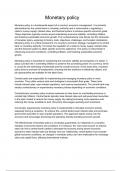Monetary policy
Monetary policy is a fundamental aspect of a country's economic management. It is primarily
administered by the central bank or monetary authority and is instrumental in regulating a
nation's money supply, interest rates, and financial system to achieve specific economic goals.
These objectives typically revolve around maintaining economic stability, controlling inflation,
and fostering sustainable economic growth. This comprehensive note delves into the intricacies
of monetary policy, exploring its history, tools, objectives, challenges, and broader implications.
Monetary policy is a critical component of a country's economic strategy, managed by its central
bank or monetary authority. It involves the regulation of a nation's money supply, interest rates,
and the financial system to attain specific economic objectives. This policy is instrumental in
influencing economic conditions, controlling inflation, and fostering sustainable economic
growth.
Monetary policy is essential for maintaining the economic stability and prosperity of a nation. It
plays a pivotal role in controlling inflation to preserve the purchasing power of a currency, which
is crucial for the well-being of individuals and the overall economy. At the same time, monetary
policy aims to promote full employment, ensuring that the workforce is effectively utilized, and
job opportunities are available for the labor force.
Central banks are responsible for implementing and managing monetary policy in most
countries. They utilize various tools and strategies to accomplish their goals. These tools
include interest rates, open market operations, and reserve requirements. The central bank may
employ contractionary or expansionary monetary policies depending on economic conditions.
Contractionary monetary policy involves measures to slow down an overheating economy or
combat high inflation. Central banks typically raise interest rates and sell government securities
in the open market to reduce the money supply. By making borrowing more expensive and
reducing the money available to lend, this policy discourages spending and investment.
Conversely, expansionary monetary policy is implemented to stimulate economic activity,
especially during a recession. To achieve this, central banks lower interest rates and purchase
government securities in open market operations. This approach injects money into the
economy and encourages borrowing and spending, thereby boosting economic growth.
The effectiveness of monetary policy is not always guaranteed, as it depends on a complex
interplay of economic factors and conditions. For instance, the "zero lower bound" on interest
rates can limit a central bank's ability to stimulate the economy during severe economic
downturns when interest rates are already very low. Additionally, central banks must consider
global economic conditions, as changes in monetary policy can have implications for exchange
rates and capital flows, affecting international markets.
, One of the fundamental principles in modern monetary policy is the independence of central
banks. This independence is intended to shield monetary policy decisions from short-term
political considerations and pressures. Central banks are often granted autonomy to make
decisions based on economic fundamentals rather than political motivations, ensuring that
policy remains consistent and credible.
Communication and transparency are also crucial aspects of monetary policy. Central banks
regularly communicate their policy decisions and intentions to the public and financial markets
to provide clarity and reduce uncertainty. This transparency helps guide expectations and
influences economic behavior.
The implications of monetary policy extend beyond national borders. Changes in a country's
monetary policy can affect exchange rates and capital flows, potentially having ripple effects on
the global economy. This interconnectedness requires central banks to consider the broader
impact of their decisions and coordinate with other central banks when necessary.
Historical examples demonstrate the significant role of monetary policy in shaping economic
outcomes. For instance, during the 2008 financial crisis, the U.S. Federal Reserve implemented
a series of unconventional measures, such as large-scale asset purchases, to stimulate the
economy and stabilize financial markets. Similarly, the European Central Bank played a crucial
role during the Eurozone debt crisis by implementing policies to address economic challenges in
the region.
In summary, monetary policy is a fundamental instrument for influencing economic conditions
and achieving macroeconomic objectives. Its primary goals are to maintain economic stability,
control inflation, and support sustainable economic growth. While specific strategies and tools
may vary from one country to another, the ultimate aim of monetary policy is to safeguard the
economic well-being and prosperity of a nation.
**Historical Evolution of Monetary Policy**
The concept of monetary policy has a long history that dates back to ancient civilizations.
However, the modern framework of central banks and monetary policy as we know it today has
evolved over time.
The establishment of central banks in various countries played a pivotal role in shaping
monetary policy. The Bank of England, founded in 1694, is often considered one of the world's
first central banks. It was created to raise funds for the British government and to stabilize the
nation's currency. Over time, central banks took on broader responsibilities, including managing
the money supply and regulating the banking system.
In the United States, the Federal Reserve System, commonly referred to as the Federal
Reserve or the Fed, was established in 1913. It was created in response to a series of financial
panics and banking crises in the 19th and early 20th centuries. The Fed was given the mandate




